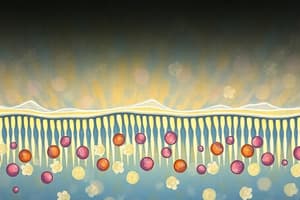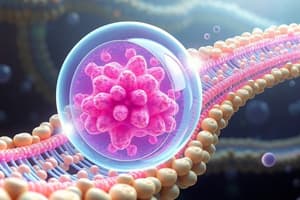Podcast
Questions and Answers
Which type of molecules can pass through the phospholipid layers of the plasma membrane via simple diffusion?
Which type of molecules can pass through the phospholipid layers of the plasma membrane via simple diffusion?
- Nonpolar molecules (correct)
- Large organic molecules
- Hydrophilic molecules
- Ions
What type of proteins are involved in the simple diffusion of ions through the membrane?
What type of proteins are involved in the simple diffusion of ions through the membrane?
- Carrier proteins
- Receptor proteins
- Channel proteins (correct)
- Enzymes
Which process involves carrier proteins that undergo a conformational change to release molecules on the other side of the membrane?
Which process involves carrier proteins that undergo a conformational change to release molecules on the other side of the membrane?
- Active transport
- Endocytosis
- Facilitated diffusion (correct)
- Simple diffusion
Which molecules can pass through the lipid portion of the membrane easily?
Which molecules can pass through the lipid portion of the membrane easily?
Gas exchange for O2 into cells and CO2 out of cells due to concentration gradients mainly occurs in which part of the body?
Gas exchange for O2 into cells and CO2 out of cells due to concentration gradients mainly occurs in which part of the body?
What specific channels allow water to pass through the plasma membrane in a process called osmosis?
What specific channels allow water to pass through the plasma membrane in a process called osmosis?
Which statement best describes the movement of water during osmosis?
Which statement best describes the movement of water during osmosis?
What is the relationship between the solute concentration of a solution and its osmotic pressure?
What is the relationship between the solute concentration of a solution and its osmotic pressure?
What is the osmotic pressure of pure water?
What is the osmotic pressure of pure water?
What is the primary force that drives the process of osmosis?
What is the primary force that drives the process of osmosis?
What is the purpose of osmotic pressure?
What is the purpose of osmotic pressure?
Which of the following best describes the role of a semi-permeable membrane in the process of osmosis?
Which of the following best describes the role of a semi-permeable membrane in the process of osmosis?
What is the main function of osmoreceptors in the hypothalamus?
What is the main function of osmoreceptors in the hypothalamus?
What is the main effect of a lower plasma osmolality on the osmoreceptors in the hypothalamus?
What is the main effect of a lower plasma osmolality on the osmoreceptors in the hypothalamus?
What is the primary role of carrier proteins in the plasma membrane?
What is the primary role of carrier proteins in the plasma membrane?
Which of the following is a characteristic of carrier proteins in the plasma membrane?
Which of the following is a characteristic of carrier proteins in the plasma membrane?
How does facilitated diffusion differ from simple diffusion?
How does facilitated diffusion differ from simple diffusion?
What is the primary difference between osmoreceptors and carrier proteins in the plasma membrane?
What is the primary difference between osmoreceptors and carrier proteins in the plasma membrane?
What is the primary purpose of the Na+/K+ pump?
What is the primary purpose of the Na+/K+ pump?
Which of the following is NOT a step in the Na+/K+ pump mechanism?
Which of the following is NOT a step in the Na+/K+ pump mechanism?
What is the key difference between primary and secondary active transport?
What is the key difference between primary and secondary active transport?
What is the role of the sodium gradient in secondary active transport?
What is the role of the sodium gradient in secondary active transport?
What is the primary requirement for the fusion of a vesicle with the plasma membrane?
What is the primary requirement for the fusion of a vesicle with the plasma membrane?
What is the purpose of the shape changes in the Na+/K+ pump mechanism?
What is the purpose of the shape changes in the Na+/K+ pump mechanism?
What is the main mechanism by which large molecules, such as cholesterol, are transported into the cell?
What is the main mechanism by which large molecules, such as cholesterol, are transported into the cell?
What is the primary factor that contributes to the difference in charge on each side of the plasma membrane?
What is the primary factor that contributes to the difference in charge on each side of the plasma membrane?
What is the role of ATP hydrolysis in the Na+/K+ pump mechanism?
What is the role of ATP hydrolysis in the Na+/K+ pump mechanism?
What is the term used to describe the difference in charge on each side of the plasma membrane?
What is the term used to describe the difference in charge on each side of the plasma membrane?
Which of the following is true about the membrane potential?
Which of the following is true about the membrane potential?
What is the relationship between the membrane potential and the charge difference across the plasma membrane?
What is the relationship between the membrane potential and the charge difference across the plasma membrane?
Flashcards are hidden until you start studying




